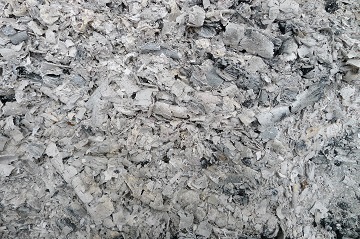Ash

Ash is the solid, somewhat powdery substance that is left over after any fuel undergoes combustion. Broadly speaking, coal ash and wood ash are the two most talked about types of ash, although ash is created during any process of incomplete combustion. Due to the variety of potential fuels, the chemical composition and even appearance of ash can vary drastically.
Incomplete combustion means that there is not enough oxygen present when the material is burned to completely consume the fuel.[2] Instead of only carbon dioxide and water vapour being created, incomplete combustion can result in the production of soot, smoke, and ash. Depending on what is burned, ash can consist of different chemical components. However, the main chemical component of ash is carbon, with varying amounts of other elements including calcium, magnesium, potassium, and phosphorus - all of which were not burned when the fuel was used.
Coal Ash
Coal ash is a collection of different sized particulates that are formed as a result of coal combustion in a coal-fired power plant. This ash can be broken up into several different categories of material, including fly ash, bottom ash, boiler slag, and flue gas desulfurization material.[3] The production of coal ash is concerning, simply because large amounts it are produced as a result of coal use. In addition to concerns about the sheer volume of coal ash, coal ash itself is harmful if released into the environment because it contains lead, arsenic, mercury, cadmium, and uranium.[4] These pollutants within ash makes it ecologically important to appropriately dispose of ash.
Wood Ash
Wood ash is a collection of different sized particulates that are formed as a result of the combustion of wood. This ash is typically powdery and can be fairly useful due to its high content of a variety of minerals. Wood ash can be used to repel slugs and snails in gardens, de-skunk pets, melt ice, clean glass, enrich compost, and even shine silver.[5]
Health Impacts
Traditional wood ash that is produced in small volumes in fireplaces in the home is generally not harmful unless inhaled. However, homes that rely on wood-burning fires for heat, light, or for cooking can have higher levels of indoor air pollution which is harmful for human health. The lack of access to non-solid fuels for use inside the home is a significant issue in some parts of the world. For more information on this topic in particular, click here. Ash can become airborne in smoke when wood is burned, and this particle pollution can damage lung tissue and lead to serious respiratory problems.[6]
Coal ash is more harmful to human health as it is sometimes released into the air and contains a wider range of potentially dangerous chemicals. Fly ash in particular is a pollutant, and it contains acidic, toxic, and radioactive matter.[7] This ash can contain lead, arsenic, mercury, cadmium, and uranium.[3] The EPA found that significant exposure to fly ash and other components of coal ash increases a persons risk of developing cancer and other respiratory diseases. Inhalation is not as much of an issue with bottom ash as it is much heavier than fly ash, but ingestion of bottom ash can have nervous system impacts, cause cognitive defects, developmental delays, and behavioral problems along with increasing a persons chance of developing lung disease, kidney disease, and gastrointestinal illness.[8]
For Further Reading
- Air pollution
- Combustion
- Fuel
- Pollutant
- Or explore a random page
References
- ↑ Wikimedia Commons. (September 12, 2015). Wood Ash [Online]. Available: https://upload.wikimedia.org/wikipedia/commons/0/09/Wood_ash.jpg
- ↑ ScienceLearn. (September 12, 2015). What is smoke? [Online]. Available: http://sciencelearn.org.nz/Contexts/Fire/Science-Ideas-and-Concepts/What-is-smoke
- ↑ 3.0 3.1 Ed Dodge. (September 12, 2015). Can Coal Fly Ash Waste Be Put to Good Use? [Online]. Available: http://breakingenergy.com/2014/02/18/can-coal-fly-ash-waste-be-put-to-good-use/
- ↑ Clean Water Action. (September 12, 2015). Managing Coal Ash [Online]. Available: http://cleanwateraction.org/page/managing-coal-ash
- ↑ Mark Feirer. (September 12, 2015). 10 Uses for Wood Ashes [Online]. Available: http://www.thisoldhouse.com/toh/article/0,,1581470,00.html
- ↑ US EPA. (September 12, 2015). Indoor Air: Residential Wood Burning [Online]. Available: http://www.epa.gov/airquality/community/details/i-woodstoves_addl_info.html
- ↑ J.Fay, D. Golomb. Energy and the Environment, 1st ed. New York, U.S.A.: Oxford, 2002.
- ↑ PSR. (September 12, 2015). Coal Ash: Hazardous to Human Health [Online]. Available: http://www.psr.org/assets/pdfs/coal-ash-hazardous-to-human-health.pdf

